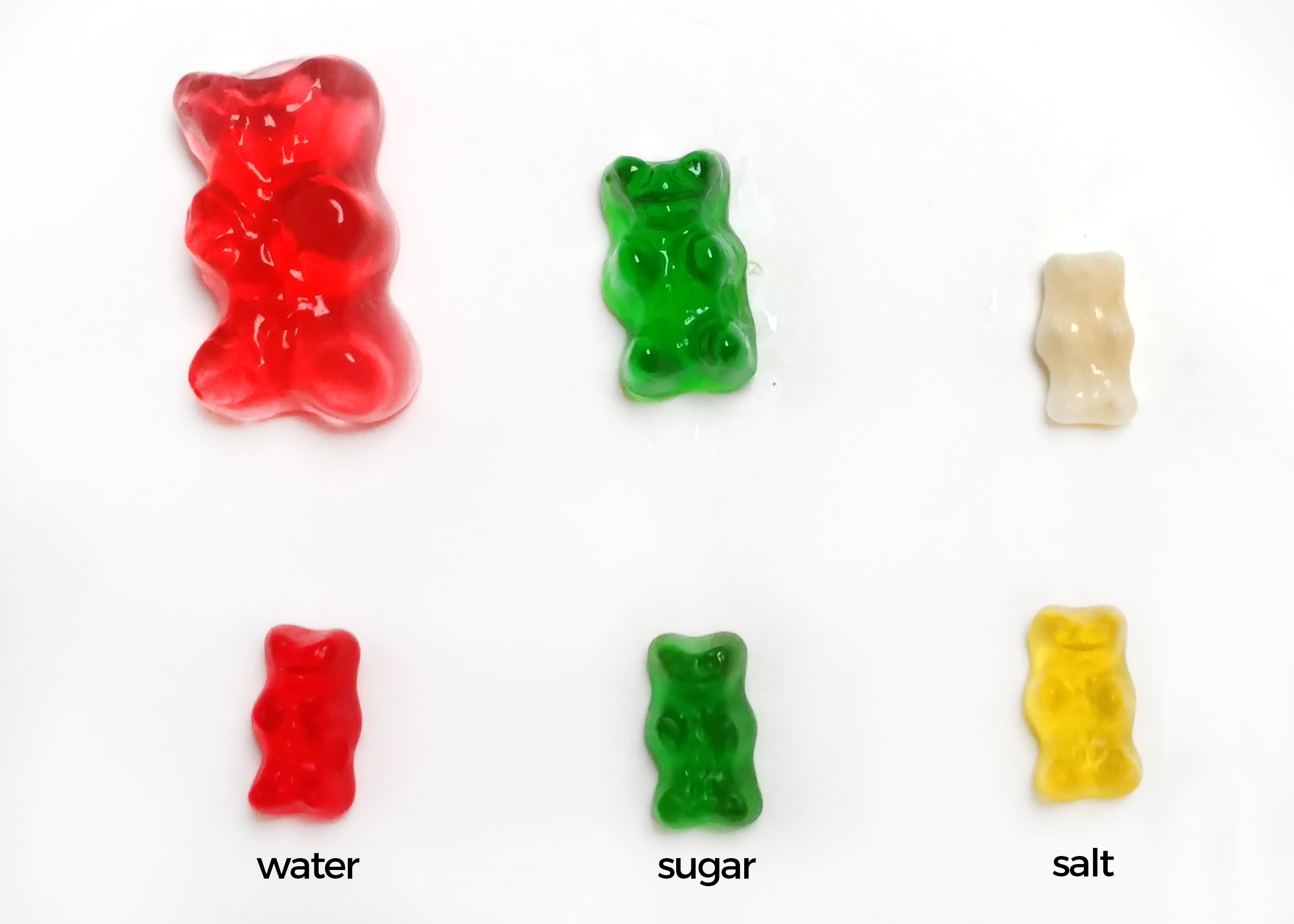Step-by-step tutorial
Warning
After the bears go into the water (or salt water, or sugar water), do NOT allow your child to eat them. Bacteria could start growing in the water as the bears soak, making them unsafe to eat.
Learn more
Spoiler alert: this experiment explores osmosis. That’s a chemistry term for the motion of water through a barrier (like a gummy bear). If you give this a try, you’ll see that the gummy bear in the plain water will grow — a lot! One question that might come up is why gummy bears grow when other candies (like peppermints) dissolve. That’s because gummy bears, unlike peppermints, contain gelatin (which doesn’t dissolve in water) as well as sugar (which does). If you zoomed way in to look at the individual gelatin molecules, you’d see that they’re all tangled together, with tiny pockets in between where liquid can get trapped. As you’ll see in this experiment, those pockets can hold a lot of liquid! This strong but flexible gelatin structure is what makes gummies, well, gummy. Give it a try and see what happens, or scroll to the bottom for more about gummy bear osmosis!
Step 1
Heat 1 cup of water over the stove. Slowly add salt to it and stir. (You’ll need around 7-9 tablespoons.) Continue adding salt until it no longer dissolves and a few salt crystals remain at the bottom. You now have a supersaturated salt solution.

Tip
You can skip the heating step if you’re working with younger kids or if you just don’t want to spend the time. The experiment will still work and you’ll see similar results — the bears may just be somewhat different sizes as ours.
Step 2
Pour the salt solution into a bowl. Let the mixture come to room temperature. Repeat steps 1 and 2 with sugar instead of salt to get a supersaturated sugar solution.

Step 3
Finally, fill the last bowl with normal water. You now have three bowls filled with different solutions.

Step 4
Take your gummy bears and place a few in each bowl. Remember to save a few as control tests. Let the bears sit in the bowls for 12-72 hours. How do you think the bears will react with each solution?

Step 5
Now observe the bears! (These are our bears after 48 hours.) You can use a kitchen scale to see how heavy each bear is using the control bears as a reference point. Are some bears more jiggly than others? Did the color change at all? Can you find a way to shrink the largest gummy? Continue to experiment by soaking your bears in different liquids and different concentrations!

Learn more
When you drop a gummy bear into plain water, you’ll see the bear grow and grow as water flows into the bear. Why? The water moves to even out the stuff dissolved in it. Outside the gummy bear, you have water with nothing in it. Inside the gummy bear (trapped inside those pockets in the gelatin), you have water + sugar. There’s more stuff inside the bear, so the water moves into the bear to try and make the proportion of sugar molecules to water the same in both places. (You can think about this like a sugar cube dissolving in a cup of water. If you let it sit for long enough, the water at the top of the cup will be as sweet as the water at the bottom.) So what about the salt water? You still have water + sugar inside of the bear. But outside of the bear, you have water + salt. Salt molecules are much smaller than sugar molecules, so more of them will dissolve in water. This means there’s more stuff in the water than there is inside the bear. So this time the water moves out of the bear to try and even things out. The sugar water is an interesting case because just like the salt, you have a lot of stuff dissolved in the water outside of the bear. But this time, we saw the water flowing into the bear, not out. That tells us that there must be more sugar inside the bear than there is in the water outside.
Final result!
You don’t need to stop here! You can try changing the amount of sugar and salt, or test out different liquids. Or, to add a little bit of math to the activity, weigh your gummy bears on a kitchen scale every day and make a chart of how it changes over time. Happy experimenting!

